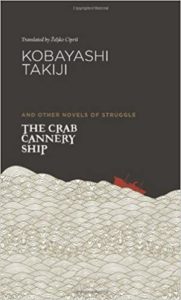The Crab Cannery Ship and Other Novels of Struggle
Takiji Kobayashi
 This book consists of three novellas, all written in the late 1920s/early 1930s. All three concern class struggles, the rising of the working class, and the left-wing movements in Hokkaido.
This book consists of three novellas, all written in the late 1920s/early 1930s. All three concern class struggles, the rising of the working class, and the left-wing movements in Hokkaido.
- The Crab Cannery Ship is a novella about a season of crab fishing near the Russian peninsula of Kamchatka. Neither factory nor ship, local fishermen and other laborers from Hokkaido have to endure unspeakable hardships to feed their families, until, at last, there is an uprising…
- Upon the jailing of her brother, Okei and her mother must move to Otaru to make ends meet. Yasuko, the younger sister works there already, in a small restaurant. When she gets involved with Yamada, a member of the worker’s union, the lives of both sisters change, but whether it’s a change for the better remains to be seen.
- Life of a Party Member is exactly that, the struggles of a member of the left-wing party who is forced into the underground. However, he still keeps up his work to convert people to the socialist movement. It is not clear whether this piece is autobiographical.
The three stories in this book can probably be called left-wing propagandist literature, and the author, as a member of the labour movement does nothing to hide it. However, the writing is incredibly vivid and conjures up dreary pictures of the lives of impoverished people. I felt very drawn to the protagonists, and was ready to step in to help, all the while seeing through some of the more obvious propaganda (of course, with almost 100 years of hindsight). The first story was republished in 2008 and became a bestseller in Japan, a sign for the constant need to make a change, I guess.
Takiji Kobayashi was born in 1903 and moved to Hokkaido as a small child. He started writing short stories and published them when at university, and at that time he became a member of the labour movement. “The Crab Cannery Ship” was written in 1929 and it sold 15.000 copies before it was banned. He continued to write more stories and books in support of the labour movement and socialist ideas. In 1931, Kobayashi became an official member of the already outlawed Japanese Communist party, and one year later, he went underground. In 1933 he was captured by the police, tortured, and died while in custody – officially – from a “heart attack”.
If you’d like to read this book that became a bestseller and sold 500.000 copies 80 years after it was published, head over to amazon.
